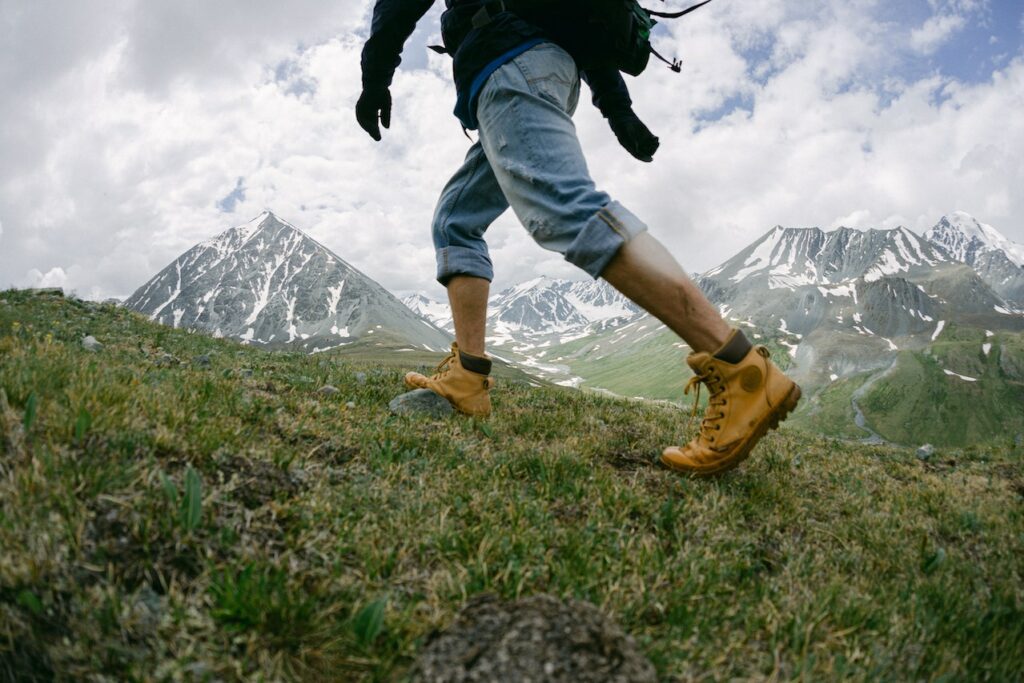Table of Contents
Outdoor enthusiasts know that choosing the right footwear is crucial for a comfortable and enjoyable experience. One essential aspect of hiking boots that often gets overlooked is cushioning and the different types of cushioned hiking boots. In this article, we’ll dive into the role of cushioning in hiking boots and discuss how to find the perfect balance of comfort and performance for your needs.

Cushioned hiking boots?
Cushioning refers to the padding or shock-absorbing material used in the midsole of hiking boots. This material helps protect your feet from the impact of each step and provides comfort during long hikes, runs, or climbs. The primary purpose of cushioning is to absorb shock and reduce the stress on your feet, ankles, knees, and hips during outdoor activities.
Types of Cushioning Materials
There are several materials commonly used for cushioning in hiking boots. Each material has its benefits and drawbacks, and the choice of cushioning material can significantly impact the overall performance and comfort of your shoes.
1. EVA (Ethylene Vinyl Acetate)
EVA is a lightweight and flexible foam material commonly used in the midsoles of hiking boots. It provides excellent shock absorption and cushioning, making it a popular choice for hiking and running shoes. However, EVA can compress over time, reducing its effectiveness as a cushioning material.
2. PU (Polyurethane)
PU is a denser and more durable foam material used in the midsoles of some hiking boots. It offers better shock absorption and support than EVA, making it well-suited for more rugged or demanding outdoor activities. However, PU is heavier than EVA, which can be a drawback for some users.
3. TPU (Thermoplastic Polyurethane)
TPU is a lightweight, durable, and flexible plastic material often used in the midsoles of hiking boots. It provides excellent shock absorption and stability, making it an excellent choice for more demanding activities like backpacking and mountaineering. TPU is more resistant to compression than EVA, ensuring a longer-lasting cushioning effect.
Factors to Consider When Choosing hiking boots Cushioning
There are several factors to consider when determining the appropriate level of cushioning for your hiking boots:
1. Activity Type
Different outdoor activities require varying levels of cushioning for optimal comfort and performance:
- Hiking and Backpacking: Adequate cushioning is essential for hiking and backpacking to minimize the impact on your joints during long days on the trail. Choose footwear with a good balance of cushioning and support to ensure comfort and stability over uneven terrain.
- Trail Running: Trail running shoes generally have more cushioning than hiking shoes to absorb the impact of each stride. Look for shoes with a responsive cushioning material that provides a good balance of shock absorption and energy return.
- Climbing: Cushioning is generally less critical for climbing shoes, as the focus is on precise foot placement and grip. However, some cushioning can provide additional comfort during long climbs or descents.
2. Personal Preference
Some individuals prefer more cushioning for a plush, comfortable feel, while others prefer less cushioning for a more responsive, ground-feel experience. Ultimately, the level of cushioning that works best for you will come down to personal preference and comfort.
3. Body Weight
Your body weight can impact the amount of cushioning you need in your hiking boots. Heavier individuals may require more cushioning to effectively absorb the impact of each step, while lighter individuals may prefer less cushioning for a more responsive feel.
4. Terrain
The type of terrain you’ll be encountering on your outdoor adventures can also influence your cushioning needs. Rough, rocky, or uneven terrain may require more cushioning to protect your feet and joints from the impact of each step. On the other hand, smoother or softer terrain may necessitate less cushioning for better ground-feel and stability.
Balancing Cushioning and Performance
Striking the right balance between cushioning and performance is essential when choosing hiking boots. Here are some tips to help you find the perfect balance:
1. Prioritize Your Needs
Identify the primary activities you’ll be engaging in and prioritize your footwear needs accordingly. If you mainly hike on rugged terrain or carry a heavy backpack, prioritize cushioning and support. Conversely, if you mostly run on smooth trails, focus on lightweight and responsive cushioning.
2. Test Different Cushioning Levels
Trying on different shoes with varying cushioning levels can help you determine the most comfortable and suitable option for your needs. Visit a specialty outdoor retailer, and take the time to walk or run in each pair to get a feel for the cushioning and overall performance.
3. Consider Stack Height
Stack height refers to the thickness of the shoe’s midsole, which can give you an idea of the amount of cushioning provided. A higher stack height generally indicates more cushioning, while a lower stack height means less cushioning and a more ground-feel experience.
4. Don’t Forget About Support
While cushioning is essential for comfort, don’t overlook the importance of support and stability in your hiking boots. A shoe with excellent cushioning but poor support may not provide the performance and protection you need on challenging terrain.
5. Break-In Period
Keep in mind that the cushioning of new hiking boots may feel stiffer initially and require a break-in period to achieve optimal comfort. Give your new shoes some time to break in before embarking on long or demanding outdoor adventures.
Conclusion
Understanding the role of cushioning in hiking boots is crucial for finding the perfect pair of shoes for your needs. By considering factors such as activity type, personal preference, body weight, and terrain, you can strike the right balance between comfort and performance. Ultimately, taking the time to try on different shoes and prioritize your specific needs will help ensure a comfortable and enjoyable outdoor experience. Don’t forget to keep your hiking boots clean.



